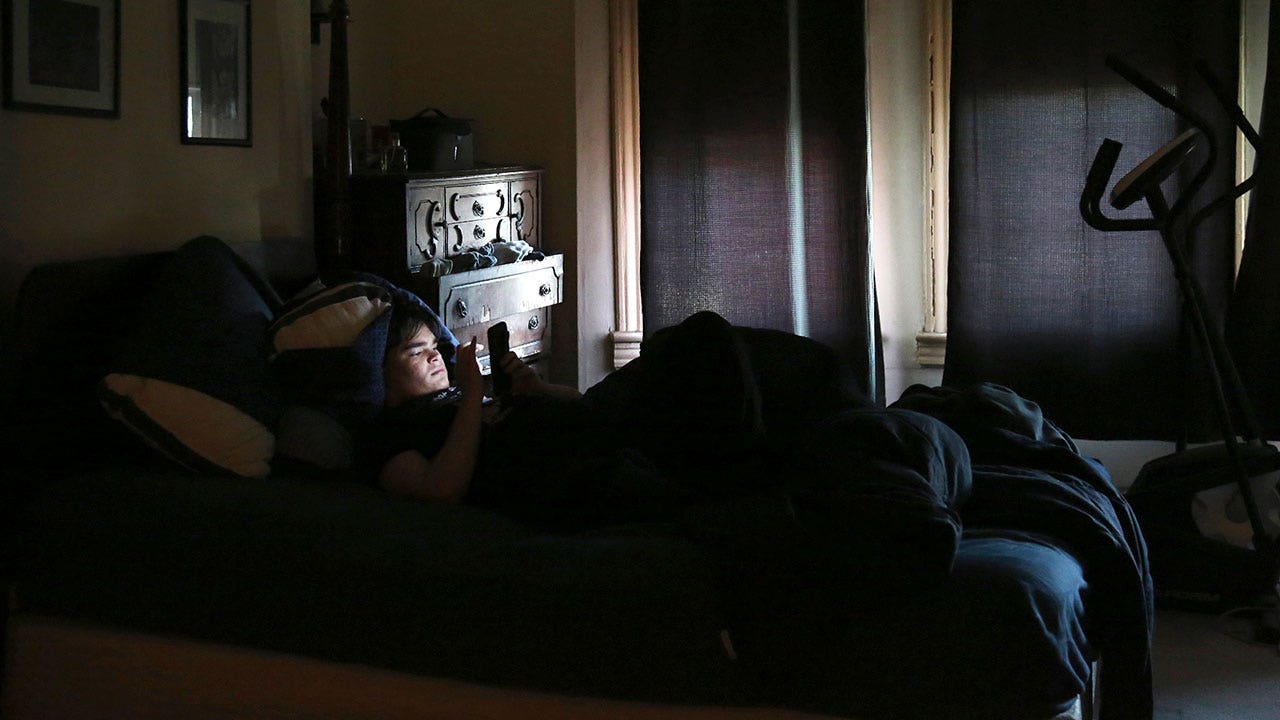Health
Sleep experts sound alarm on late night screen time: How your phone could be sabotaging your rest

- More than half of Americans use their phones within an hour before bedtime, according to the National Sleep Foundation.
- Experts recommend shutting off devices earlier for better quality of sleep.
- Breaking the habit involves redesigning nighttime routines by replacing screen time with activities like reading or spending time with family.
Like many of us, Jessica Peoples has heard the warnings about excessive screen time at night. Still, she estimates spending 30 to 60 minutes on her phone before going to sleep, mostly scrolling through social media.
“Recently, I’ve been trying to limit the amount,” says Peoples, a discrimination investigator with the state of New Jersey. “I do notice that how much time I spend affects how long it takes to fall asleep.”
Over half of Americans spend time on their phones within an hour of going to sleep, according to a survey by the National Sleep Foundation. That’s the very latest we should shut off devices, experts say.
‘BED ROTTING’ IS SELF-CARE, SOME INSIST, BUT MENTAL HEALTH EXPERT SHARES WARNINGS ABOUT SOCIAL MEDIA TREND
The brain needs to wind down long before bedtime to get the restorative deep sleep that helps the body function, said Melissa Milanak, an associate professor at Medical University of South Carolina specializing in sleep health.
James Walter uses a phone at home in the Queens borough of New York, on April 7, 2021. Sleep scientists long ago established that insufficient sleep is linked with poor health outcomes, anxiety, obesity and several other negative effects. The research is equally conclusive that smartphones are particularly disruptive to the circadian clock that regulates sleep and other hormones. (AP Photo/Jessie Wardarski, File)
“You wouldn’t take a casserole out of the oven and stick it right in the fridge. It needs to cool down,” Milanak said. “Our brains need to do that too.”
Upending your bedtime routine may not be easy, but insufficient sleep has long been linked to anxiety, obesity and other negative outcomes. Research shows smartphones are particularly disruptive to the circadian clock that regulates sleep and other hormones.
“There are a million and one ways screens create problems with sleep,” said Lisa Strauss, a licensed psychologist specializing in cognitive behavioral treatment of sleep disorders.
The brain, she said, processes electric light — not just a smartphone’s much-maligned blue light — as sunshine. That suppresses melatonin production, delaying deep sleep. Even very little bright-light exposure in bed has an impact.
IT’S NOT JUST THE LIGHT THAT KEEPS YOU UP
Of course, doomscrolling through the news, checking emails or being tempted by ever more tailored videos on social media has its own consequences.
So-called “technostress” amps you up — possibly even triggering the brain’s flight or flight response. And algorithms designed to be engaging compel many social media users to scroll longer than they intended.
“Now it’s 30 minutes later, when you wanted to watch a couple videos and fall asleep,” Milanak said.
Though much of the scientific research on online media focuses on adolescents and young adults, Strauss said most of her clients struggling with insomnia are middle-aged. “People go down these rabbit holes of videos, and more and more people are getting hooked,” she said.
HOW TO BREAK THE HABIT
The issue is not just curtailing phone use in bed, but phone use at night. That means redesigning your routine, particularly if you use your phone as a way to decompress.
It helps to create replacement behaviors that are rewarding. An obvious contender is reading a physical book (e-readers are better than phones but still cast artificial light). Milanak also suggests using that hour before bed to take a warm bath, listen to a podcast, make school lunches for the next day, spend time with family or call a relative in another time zone.
“Make a list of things you like that never get done. That’s a great time to do stuff that doesn’t involve screens,” she said. Using a notepad to write down the to-do list for the next day helps keep you from ruminating in bed.
Do those activities in another room to train yourself to associate the bed with falling asleep. If there’s no other private refuge at home, “establish a distinct microenvironment for wakefulness and sleep,” Strauss said. That could mean sitting on the other side of the bed to read, or even just turning the other way around with your feet at the headboard.
Finally, sequester the phone in another room, or at least across the room. “Environmental control can work better than will power, especially when we’re tired,” she said.
WHAT IF STOPPING DOESN’T FEEL REALISTIC?
There are ways to reduce the harm. Setting the phone on night mode at a scheduled time every day is better than nothing, as is reducing screen brightness every night. Hold the phone far from your face and at an oblique angle to minimize the strength of the light.
Minimize tempting notifications by putting the phone on do not disturb, which can be adjusted to allow calls and messages from certain people — say, an ailing parent or a kid off at university — to go through. But none of these measures give you carte blanche to look at whatever you want at night, Strauss said.
She also recommended asking yourself why checking social media has become your late-night reward.
“Think about the larger structure of the day,” she said. Everyone deserves solitary moments to relax, but “maybe be more self-indulgent earlier so you have what you need.”

Health
How to easily start an outdoor exercise routine

- For those who do not enjoy working out in a gym, choosing to exercise outdoors can make a great alternative.
- To get started, build on what you enjoy. If that is hiking or biking, take longer walks and rides until you’re comfortable being active for about 45 minutes.
- To stay motivated and consistent, it can be helpful to recruit an exercise buddy and get appropriate clothing that will keep you warm and dry in inclement weather.
Between the sweat smell, fluorescent lights and omnipresent television screens, April Herring has never connected with going to the gym.
Instead, she runs, bikes, hikes, plays tennis, pickleball and football — anything to get her exercise outside as often as possible.
“Fresh air, sunshine, the variety of the trees as the seasons change,” said Herring, an administrator at Carroll Community College in North Maryland. “There’s something about the energetic healing quality of nature.”
GET THIS FITNESS GEAR THAT’S ACTUALLY COMFORTABLE TO WORKOUT IN
The health benefits of spending time in nature have long been established, and exercise in general, of course, improves physical and mental well-being.
Combine the two and you double down on what adults need to stay healthy, said Debbie Rhea, professor in kinesiology at Texas Christian University.
“We’ve got to get outside. We’ve got to be active,” Rhea said. “If we’re going to live long lives, this is what it’s about.”
Racers compete for the title of “King and Queen” of The Alpine Training Center Gym in Boulder, Colorado, on July 26, 2023. Exercising outdoors combines the health benefits of physical activity with those of spending time in nature. (Scott Griesser via AP)
Getting started on an outdoor routine, however, might not be as easy as signing up for another gym membership. Here’s how to get going.
START SIMPLE WITH WHAT YOU LIKE
If you haven’t been active for a while, think back to the activities you enjoyed years ago, suggested Connie Sciolino, founder of the Alpine Training Center in Boulder, Colorado, a gym that trains athletes for outdoor mountain sports.
People who like occasionally hiking or biking should start building an aerobic base by taking progressively longer walks or rides. Once you’re comfortably in the 35- to 45-minute range, start adding some intensity to build strength, she said.
“If jogging is their main activity, I would send them to the bleachers or do some up-down on stairs, either in sprint format or put a pack on their back,” she said.
Rhea cautioned against jumping back into a sport you used to play without preparing your body for the proper movement.
“Let’s say they’re in their 30s, 40s, 50s, and they haven’t sprinted and now they try to run around those bases,” she said. “They’re probably going to hurt an Achilles or a hamstring or something by doing something too fast.”
THEN BUILD STRENGTH WITH WHAT’S AROUND
A side benefit of exercising outside is that there’s no need to buy expensive equipment, trainers say.
After warming up with your preferred aerobic activity, add strength training by using your body weight and what is available in the built environment. That could be finding a picnic table or low wall and placing your hands shoulder-width apart to do leaning pushups. Then turn around, put your hands on the same surface and lower your body for dips that work your triceps.
For working your legs, add squats with your feet shoulder-width apart, looking straight ahead with your back straight. Add lunges by taking giant steps and bending down into the space between your feet. For the core, find a patch of grass to do sit-ups.
Start with eight to 10 repetitions, or no more than you are comfortable with, and add sets with short breaks in between as you get stronger.
For a more complete workout, find a park or trail with outdoor exercise equipment, which is installed in one-third of park agencies, according to the National Recreation and Park Association. The equipment can range from basic pull-up bars to gym-style bench presses and rowing machines.
And many cities, including Chicago, San Antonio and Atlanta, offer free group classes outdoors.
HOW TO STAY MOTIVATED — EVEN IN BAD WEATHER
When it inevitably rains or the weather turns colder, it helps to keep in mind an old axiom: There’s no such thing as bad weather, only bad clothing.
“If we have the clothing for whatever the temperatures are that we may be in, then we’re more likely to go outside to be active when we need to,” Rhea said.
She suggested investing in a jacket that breathes and a light hat with a brim you can use on sunny or rainy days.
Trainer Katie Higginbotham recommended having a contingency plan for inclement weather. Pick an area with surfaces that won’t get slippery when wet or somewhere with some tree shelter so as not to be bombarded by rain.
On those days, having a regular exercise buddy really helps, said Higginbotham, who oversees quality control for TrainFitness, a U.K.-based private training provider.
“If you know someone is there waiting for you, it’s difficult to say no at the last minute,” she said.
Finally, it helps to set a goal, whether that is training for a 5K charity walk or a triathlon. If you’re working toward something, it keeps you motivated to keep going, Sciolino said.
“When you have that day marked on your calendar, you have to perform these things or die out there,” she said.
Health
Ozempic and Wegovy could double as kidney disease treatment, study suggests

Ozempic prescriptions in Los Angeles surge 162%
Fox News medical contributor Dr. Marc Siegel discussed the surge of Ozempic prescriptions, his reaction to the Pope saying a migrant ‘has to be received’ and a spike in hepatitis cases in the homeless population in Los Angeles.
Semaglutide medications — including Ozempic and Wegovy — have been shown to reduce the risk of kidney failure and the risk of death among people with kidney disease and type 2 diabetes.
In a trial led by UNSW Sydney between June 2019 and May 2021, researchers found that a small weekly dose of semaglutide lessened the likelihood of “major kidney events” by 24%, according to a press release.
The study, funded by Novo Nordisk and published in The New England Journal of Medicine, included more than 3,500 participants with type 2 diabetes and chronic kidney disease from 28 countries.
OZEMPIC, WEGOVY MAY BE LINKED TO STOMACH PARALYSIS AND OTHER DIGESTIVE ISSUES IN LARGE-SCALE STUDY
The participants received 1.0 mg per week of semaglutide, which is less than what is typically prescribed for weight loss or diabetes, the release noted.
The median follow-up was 3.4 years.
Semaglutide medications — including Ozempic and Wegovy — have been shown to reduce the risk of kidney failure and the risk of death among people with kidney disease and type 2 diabetes. (iStock)
“It’s the same chemical compound, but we used a lower dose … we did that deliberately because people with kidney disease tend to be more sensitive to the effects and side effects of drugs,” said the study’s lead author, professor Vlado Perkovic of UNSW Sydney, in the release.
“That’s helpful in terms of being able to perhaps have the drug more widely used than might have otherwise been the case given the current supply limitations.”
OZEMPIC DIABETES AND WEIGHT LOSS MEDICATION UNDER INVESTIGATION AFTER A FEW REPORTS OF SUICIDAL THOUGHTS
The group of people taking semaglutide were also 18% less likely to experience a heart attack, stroke and other cardiovascular events, the study found.
Why does semaglutide have this effect?
Patients with type 2 diabetes and chronic kidney disease are at a significant risk for kidney failure, cardiovascular events and death, according to Dr. Brett Osborn, a neurologist and longevity expert in Florida.
“The recent study published in the New England Journal of Medicine highlights semaglutide’s potential to mitigate these risks,” Osborn, who was not involved in the study, told Fox News Digital.

Dr. Brett Osborn, a neurologist and longevity expert in Florida, noted that patients with type 2 diabetes and chronic kidney disease are at a significant risk for kidney failure, cardiovascular events and death. (Dr. Brett Osborn)
Semaglutide works by improving glycemic control, Osborn noted — which is crucial in mitigating diabetic nephropathy (kidney disease).
“It also lowers inflammation — particularly within the blood vessel lining,” he said.
OZEMPIC AND WEGOVY OVERDOSE CALLS HAVE SPIKED, EXPERTS SAY — HERE’S WHAT TO KNOW ABOUT DANGEROUS DOSES
This reduces blood vessel damage and improves blood flow through the kidneys.
“Overall, semaglutide offers substantial renal and cardiovascular protection for patients with type 2 diabetes and chronic kidney disease,” Osborn said.
“At a base level, semaglutide, through indirect mechanisms, improves vascular health. The better blood flow to your organs — be it your heart, brain or kidneys — the longer you are likely to live.”

Semaglutide works by improving glycemic control, one doctor noted, which is crucial in mitigating diabetic nephropathy (kidney disease). (Getty Images)
Outside the spectrum of diabetes, Osborn said he believes these medications will have a major impact on human health, comparing them to the advent of antibiotics at the turn of the century.
Dr. Marc Siegel, clinical professor of medicine at NYU Langone Medical Center and a Fox News medical contributor, also said this was a “very important” study.
OZEMPIC BABIES: WOMEN CLAIM WEIGHT-LOSS DRUGS ARE MAKING THEM MORE FERTILE AND EXPERTS AGREE
“This lifesaving result is likely due to the metabolic effects of the drug, which helps with reducing inflammation, overcoming insulin resistance, and improving insulin function and glucose metabolism at the cellular level,” Siegel told Fox News Digital.
“This study has broader implications for all patients who have kidney failure.”
“Improved kidney function means improved heart function, and pressure on the heart from failed kidneys is a major cause of heart attack and death.”
Siegel added, “This study has broader implications for all patients who have kidney failure or are at risk for it.”

Novo Nordisk, the Denmark-based company that makes Ozempic and Wegovy, announced the positive primary results from the trial at the European Renal Association (ERA) Congress in Sweden last week. (LISELOTTE SABROE/Scanpix Denmark/AFP via Getty Images)
Novo Nordisk, the Denmark-based company that makes Ozempic and Wegovy, announced the positive primary results from the trial at the European Renal Association (ERA) Congress in Sweden last week.
“FLOW is the first ever renal outcomes trial with a GLP-1 receptor agonist, and demonstrated a statistically significant reduction in kidney disease progression, cardiovascular death, and all-cause mortality risk with semaglutide 1 mg,” Michael Radin, executive medical director for diabetes at Novo Nordisk, said in a statement sent to Fox News Digital.
CLICK HERE TO SIGN UP FOR OUR HEALTH NEWSLETTER
“This study highlights our drive to make a meaningful difference in the lives of people living with type 2 diabetes and CKD and to deliver innovations to address current unmet medical needs in CKD pending FDA approval.”

Wegovy is an injectable prescription weight loss medicine that has helped people with obesity. (Michael Siluk/UCG/Universal Images Group via Getty Images)
To leverage semaglutide as a treatment for kidney disease, there is a need to overcome supply shortages and conduct research about combining the medication with other therapies, the researchers stated in the release.
Novo Nordisk will also need to seek regulatory approval for the drug to be used for chronic kidney disease patients.
“The challenge is to get these results into clinical practice, to get the drug used by the people who will benefit from it, who will live longer without dialysis, without heart attacks, without strokes, if they take this drug,” Perkovic said.
For more Health articles, visit www.foxnews.com/health.
Health
Horoscope: What’s in Store for You May 27 — June 2, 2024?

Sign Up
Create a free account to access exclusive content, play games, solve puzzles, test your pop-culture knowledge and receive special offers.
Already have an account? Login
Forgot your password?
Get back to the Sign In
Use left and right arrow keys to navigate between menu items.
Use escape to exit the menu.
-

 News1 week ago
News1 week agoThe states where abortion is on the ballot in November : Consider This from NPR
-

 News1 week ago
News1 week agoRead Prosecutors’ Filing on Mar-a-Lago Evidence in Trump Documents Case
-

 Politics1 week ago
Politics1 week agoMichael Cohen swore he had nothing derogatory on Trump, his ex-lawyer says – another lie – as testimony ends
-

 Politics1 week ago
Politics1 week agoAnti-Israel agitators interrupt Blinken Senate testimony, hauled out by Capitol police
-

 World1 week ago
World1 week agoSerbian parliamentary minnow pushes for 'Russian law' equivalent
-

 World1 week ago
World1 week agoWho is Ali Bagheri Kani, Iran’s acting foreign minister?
-
Technology1 week ago
Microsoft’s new Windows Copilot Runtime aims to win over AI developers
-

 News1 week ago
News1 week agoBuy-now, pay-later returns and disputes are about to get federal oversight
















/cdn.vox-cdn.com/uploads/chorus_asset/file/25458338/DSC00620.JPG)